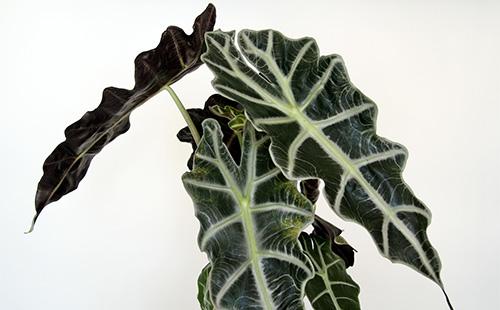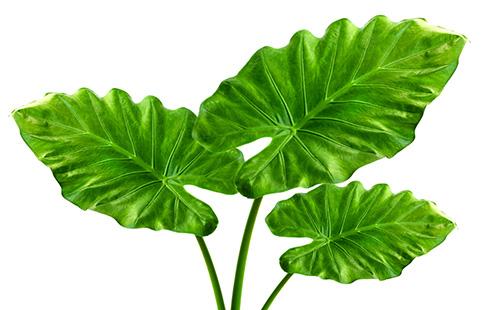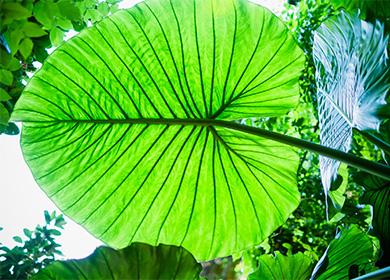The content of the article
In nature, alocasia grows in Latin America, Malaysia and Australia. Even in regions with a warm climate, it is used only as an indoor potted plant.
Botanical description and interesting features
Refers to evergreens. It has large rhizomes, from which grassy shoots depart. In shape, the roots resemble elongated tubers. Stems are shortened, erect. The leaves are large, dense, the shape depends on the variety - it happens to be thyroid, oval and heart-shaped. Petioles are dense, long; at the base of the leaf are divided into several veins. In some varieties, the length of the leaves reaches a meter. The edges are smooth or ribbed, the surface is glossy, the color of different shades of green.
It blooms extremely rarely. The peduncle is dense, shortened, in the form of a small bright cob, almost completely hidden under the coverlet. A veil is revealed only after successful pollination. The ripened fruits are red round berries, opened along the longitudinal vein.
Indoor Varieties
In total, there are about 70 types of alocasia. Only some of them are suitable for keeping in apartments.
- Amazonian. A beautiful plant with a small stem and thyroid leaves. Petioles are very long - up to one and a half meters. The color of the petioles is unusual - greenish pink. The surface of the sheet is uneven, with recesses, divided into shares. Dark colored leaves with white veins and stripes. It blooms extremely rarely in apartments. The inflorescence is a small ear, covered with a white-green veil.
- Sander. Hybrid variety. More suitable for greenhouses, but sometimes grown in apartments. It features original elongated arrow-shaped leaves. The color is green with paler green veins. Along the edges, small indentations are expressed. Rhizome tuberous, petiolate leaves.
- Lowe. Tall species up to a meter tall. The trunk is short. An interesting feature is the fastening of the petiole to the middle of the leaf. The color of the leaves is green; the veins are green or white. On the underside with a purple tint. Leaves are oval or arrow-shaped.
- Copper red. The stalk is short, sometimes hiding underground. The upper side of the leaves is copper tinged, the lower side is saturated purple. The apartments never blooms.
- Hoody. The height of the plant is up to a meter, the trunk is very short - no more than 5 cm. There is a small indentation at the base of the leaf, and a tip is at the tip. The leaves are very large, with a pronounced gloss. Sometimes it blooms, but only in adulthood. Peduncle is low - not higher than 30 cm. Inflorescence is a small cob with a small coverlet.
- Large-root. Sometimes called Indian. Very large plant.The stem can reach two meters in height, petioles - meter. The division into shares in the base of the sheet is characteristic. It blooms extremely rarely.
- Odorous. The leaves are long, petiolate, leathery. Young thyroid leaves, adults linearly ovoid. Flowers are inconspicuous, with a specific aroma. In artificial conditions, rarely blooms.
Features of care for alocasia after purchase
How to care for alocasia after purchase? If you choose a strong, healthy plant in the store, the adaptation will be quick. When buying, pay attention that there are no spots, dots. The color of the foliage is important - pale leaves with yellowness will tell about problems with the root system. At home, create all the conditions for quick adaptation.
- Quarantine. Set alocasia separately from other colors. The room should not be too hot and humid. Avoid direct sunlight, water very moderately. Quarantine alocasia for about ten days.
- Treatment. Preventively spray alocasia with a low concentration of fungicide and insecticide. The interval between treatments should be at least three days.
- Transfer. Choose the right size tank, good soil composition. Transport soil and containers are not suitable for continuous cultivation. After transplantation, adhere to gentle care - shade from the sun, water carefully.
Ten days later, the adaptation phase will be completed - alocasia can be delivered to the rest of the room flowers.
General care rules
Belongs to rather unpretentious, fast-growing cultures. Rarely ill, decorative loses only in very unfavorable growing conditions. Caring for alocasia in a pot requires compliance with a number of rules.
- Lighting. Prefers bright but diffused lighting. It grows well on the east or west side. Growing from the south side is possible only with shading. Varieties with plain leaves are less demanding on the level of illumination. Variegate varieties with a lack of light lose their characteristic color.
- Temperature. Very thermophilic plant, does not like sudden changes in temperature and drafts. In summer, a favorable temperature for development is 22-26 ° С, in autumn and winter - not lower than 18 ° С.
- Watering. In the warm season, during the period of active growth, they are watered abundantly and often enough. After the top layer has dried, wait one day before watering. Overmoistening and drying of an earthen coma is not allowed.
- Humidity. Alocasia loves high humidity. In summer, spraying is beneficial. In the cold season and in cloudy weather, it is better not to spray. It is recommended to further increase the humidity by placing small water bowls next to the plant or installing the pot in a tray with a moist filler - sphagnum, hydrogel, decorative pebbles. As a hygienic procedure, the leaves are regularly wiped with a damp cloth.
- Top dressing. Suitable standard fertilizers for indoor plants. Alternating the introduction of organic and mineral preparations. The frequency of top dressing is twice a month. During the flowering period, you can additionally feed with funds with a high content of potassium and phosphorus.
- The soil. A loose, slightly acidic, permeable soil is prepared. Its composition includes turf, peat, humus, sheet land and sand. It is useful to add chopped sphagnum and charcoal.
- Transfer. Once every two to three years, alocasia needs to be transplanted into another pot. An oversized pot is used, a drainage layer is necessarily poured to the bottom. Transplantation is preferred to conventional transplantation - the roots are quite sensitive.Each time, the diameter of the pot is increased by 2-3 cm.
All reproduction methods
Propagating alocasia is quite simple. You can use one of several methods for this. Each method of reproduction will be described in detail below.
Nodules
The most common and effective method of reproduction. Nodules form on the rhizomes of alocasia. Sometimes they grow leaves on their own. In this case, the young plant is simply gently separated and planted in a separate pot.
Sometimes nodules form on the trunk of the alocasia. They are sedimented only after the appearance of roots. So that they do not dry out, the trunk is covered with wet sphagnum. After the formation of roots and the beginning of the growth of leaves, they are planted in shallow pots.
Nodules may be dormant. They sprout for a very long time. They speed up the process by soaking the nodules in the solution of the Epin preparation. Planting soil should be very light. The best option is a mixture of perlite or sand with sphagnum. It is allowed to use pure moss provided that moisture is constantly maintained. In sphagnum, you can only germinate nodules - immediately after the appearance of signs of growth, the nodules are transplanted into suitable soil.
The nodule is laid on the soil with the "beak" upward, sprinkled with a substrate. To maintain stable humidity and heat, cover with a plastic cup or jar. Sprouts are regularly ventilated.
Apical cuttings
The method is suitable only for propagating adult alocasia varieties with a pronounced stalk. The very top of the stem can be cut and rooted. A loose mixture of sand with peat is used as a substrate.
The planted stalk must be covered with a jar or polyethylene. Some gardeners prefer to root in water. Only boiled water is taken. To prevent decay add a tablet of activated carbon. The emergence of roots is expected on average in two weeks.
Strongly grow roots is not necessary - a stalk with the rudiments of roots is immediately transplanted into a loose soil mixture. Usually they take three parts of crushed sphagnum, add one part of garden soil to it. At first, until the appearance of stable signs of growth, they are kept under cover.
Stem cuttings
If alocasia is greatly extended, has lost its decorative effect, it can be rejuvenated and several young plants can be obtained at the same time. The stem is carefully cut, divided into segments with one or two buds and root similarly to the apical cuttings.
The kidney is left above the surface of the soil. Watering and spraying regularly. Cuttings are kept under cover. It is useful to add crushed coal to the substrate in order to avoid decay of the base of the cuttings. Daily airing required.

Rhizome division
The division procedure is combined with another transplant. On each segment of the rhizome, roots and buds are left. All sections are treated with fungicides and coal powder to prevent decay and fungal infection.
Alocasia dealings are planted in containers with light sandy soil. Watered sparingly, kept under cover. The film is removed daily for half an hour to ventilate and remove accumulated condensate. From time to time, a little Epin growth stimulant can be added to water for irrigation.
Seeds
Good germination is only in fresh, recently harvested seeds of alocasia. The seed method of reproduction is rarely used, since it is not always possible to get seeds at home - alocasia practically does not bloom in apartments.
Often use store-bought planting material. It is better to sow with a margin - not all seeds will germinate. Pre-seeds are treated with "Epin" to increase germination. The substrate is taken loose, with a predominance of sand in the composition. They grow necessarily under shelter.
The first shoots appear in two to three weeks. A pick can be carried out only after the formation of these leaves - after about two to three months. All this time, they maintain a temperature of 23-24 ° C, systematically airing the greenhouse. Seedlings from seeds develop very slowly. The first large sheet will be formed only in a year.

Growing problems
Despite the unpretentiousness of alocasia, difficulties in growing are not always avoided. As a result of errors in care, infection with pests or diseases, alocasia may lose its decorative effect or die. Below is a table describing the most common problems in growing alocasia.
Table - Difficulties in growing alocasia
| Problem | Possible reasons | How to fix the problem |
|---|---|---|
| Alocasia leaves turn yellow | - The problem with the roots; - waterlogging; - complete drying of the soil; - pests | - Eliminate errors of leaving; - check for pests |
| The tips of the leaves turn dry, brown | - Insufficient watering; - dry air | - Increase humidity; - regularly sprayed |
| The leaves are dry | - pests; - systematic drying of the soil; - very low humidity | - Inspect alocasia for pests; - normalize the watering regime; - artificially increase humidity |
| The tips of the leaves turn yellow | - Use of chlorinated, hard water for irrigation; - excess nitrogen; - lack of nutrients | - Before watering, water is defended; - fertilizers are applied regularly, choosing products with a low nitrogen content |
| Spots appear on the leaves | - Powdery mildew (brown spots); - aphids (yellow spots on shriveled leaves); - mealybug | - Depending on the identified cause, fungicides or insecticides are used. |
| Alocasia is losing leaves | - Rotting rhizomes; - weakening of the plant | - Transplanted with fungicide treatment; - arrange a rest period in a cool place with moderate humidity |
| Leaves are chopped | - Lack of nutrients | - Feed out of turn |
| Leaves fade, lose color | - Lack of light | - Rearrange to a brighter place; - in winter organize additional lighting |
Recovery after illness
Resuscitating alocasia after a disease or pest attack is not always easy. A common situation is rotting of the rhizome. In the neglected state, the only way is to cut off the top to healthy tissues and root it.
The procedure is somewhat different from the standard rooting - the apical cuttings from a diseased plant take root more heavily. Before planting, the stalk is soaked for half an hour in a solution of the Fitosporin preparation, then treated with any means to stimulate root formation. For example, "heteroauxin."
How to care for alocasia so that you never have problems? Experienced growers recommend developing an optimal irrigation schedule taking into account the time of year and room temperature. Periodically, as a prophylaxis, alocasia can be treated with low doses of insecticides and fungicides. Subject to the basic rules, alocasia will delight you with its decorative leaves for many years.

